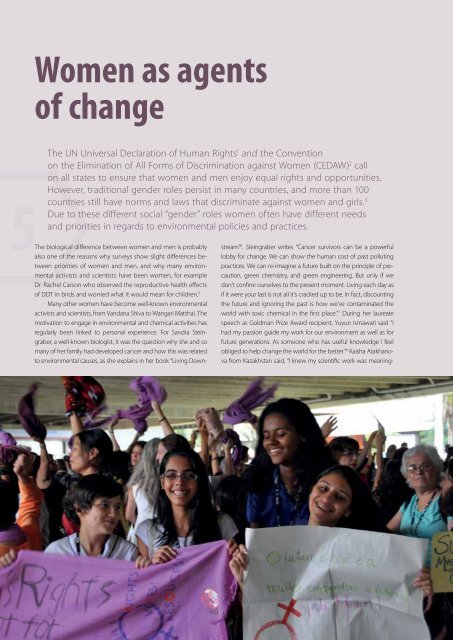Women and Chemicals
1ToENNR
1ToENNR
Create successful ePaper yourself
Turn your PDF publications into a flip-book with our unique Google optimized e-Paper software.
<strong>Women</strong> as agents<br />
of change<br />
The UN Universal Declaration of Human Rights 1 <strong>and</strong> the Convention<br />
on the Elimination of All Forms of Discrimination against <strong>Women</strong> (CEDAW) 2 call<br />
on all states to ensure that women <strong>and</strong> men enjoy equal rights <strong>and</strong> opportunities.<br />
However, traditional gender roles persist in many countries, <strong>and</strong> more than 100<br />
countries still have norms <strong>and</strong> laws that discriminate against women <strong>and</strong> girls. 3<br />
Due to these different social “gender” roles women often have different needs<br />
<strong>and</strong> priorities in regards to environmental policies <strong>and</strong> practices.<br />
5The biological difference between women <strong>and</strong> men is probably<br />
also one of the reasons why surveys show slight differences between<br />
priorities of women <strong>and</strong> men, <strong>and</strong> why many environmental<br />
activists <strong>and</strong> scientists have been women, for example<br />
Dr. Rachel Carson who observed the reproductive health effects<br />
of DDT in birds <strong>and</strong> worried what it would mean for children. 5<br />
Many other women have become well-known environmental<br />
activists <strong>and</strong> scientists, from V<strong>and</strong>ana Shiva to Wangari Matthai. The<br />
motivation to engage in environmental <strong>and</strong> chemical activities has<br />
regularly been linked to personal experience. For S<strong>and</strong>ra Steingraber,<br />
a well-known biologist, it was the question why she <strong>and</strong> so<br />
many of her family had developed cancer <strong>and</strong> how this was related<br />
to environmental causes, as she explains in her book “Living Downstream”<br />
6 . Steingraber writes “Cancer survivors can be a powerful<br />
lobby for change. We can show the human cost of past polluting<br />
practices. We can re-imagine a future built on the principle of precaution,<br />
green chemistry, <strong>and</strong> green engineering. But only if we<br />
don’t confine ourselves to the present moment. Living each day as<br />
if it were your last is not all it’s cracked up to be. In fact, discounting<br />
the future <strong>and</strong> ignoring the past is how we’ve contaminated the<br />
world with toxic chemical in the first place.” 7 During her laureate<br />
speech as Goldman Prize Award recipient, Yuyun Ismawati said “I<br />
had my passion guide my work for our environment as well as for<br />
future generations. As someone who has useful knowledge I feel<br />
obliged to help change the world for the better.” 8 Kaisha Atakhanova<br />
from Kazakhstan said, “I knew my scientific work was meaning-<br />
46


